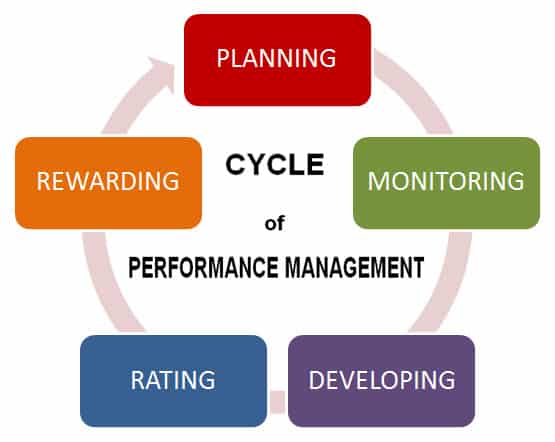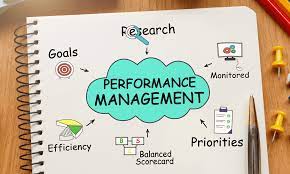Performance management is not an easy field to master. It is constantly evolving, necessitating the use of an effective management system. Every year, new performance management trends emerge, and all too often, human resources get it wrong. Employees are left feeling deflated, unmotivated, and unengaged, while managers are irritated by poor levels of team and individual employee performance. Fortunately, more and more companies are recognizing the importance (and resulting benefits) of an effective performance management system and the cycle. The first step toward revitalizing and improving your existing performance process is to understand what an effective performance management system is. To accomplish this, we shall answer the following questions;
What Is Performance Management?
Performance management is a corporate management tool that assists managers in monitoring and evaluating employees’ work. The purpose of performance management is to create an atmosphere in which people can perform to the best of their ability to deliver the highest-quality work most efficiently and effectively.
A systematic performance-management program helps managers and employees agree on expectations, goals, and career progression, as well as how individuals’ work connects with the company’s broader vision. In general, performance management considers individuals within the context of the larger workplace system. In theory, you want the absolute performance standard, but this is thought to be unreachable.
What Are the Stages of the Performance Management Cycle?
The first stage of the performance management cycle is the “Planning” phase. Planning should include the following elements:
- Agreeing on SMART objectives
- A personal development plan
- Actions to be taken in the coming months
- A review of the employee’s job requirements, with an update to the role profile if needed.
Historically, organisations would carry out this planning step once a year. However, as the business environment becomes more nimble and fast-moving, many organisations are adapting their processes to create “near-term” objectives every three months. The goals and values of the organization should be fed into performance planning to ensure that individual performance aligns with the overall strategy of the organisation. Specifically, each SMART objective should contribute to the achievement of one or more of the organization’s goals.
Organizations have placed a lot of emphasis on the “Review” section of the performance management cycle — typically because a performance assessment is necessary for reward purposes. However, we have always advised that the “Act” and “Track” stages are the most important. These are the stages at which performance is delivered and outcomes are obtained. Individuals must be encouraged to set aside regular time to work on their goals and personal development plans. Similarly, managers should check in with their workers regularly. They must provide frequent, effective feedback and use coaching skills to assist their team members in overcoming challenges and identifying opportunities for learning and improvement. If this is left until the end of the year, it is too late – objectives and development goals may only be partially met.
Performance Management Cycle

There are no arrows between the four stages in the preceding performance management cycle. This is because, in reality, the stages do not follow one another. Act and Track should be done consistently throughout the year. Reviews can take place at any moment, and planning can take place several times throughout the year, you can revisit it as the needs of the business change.
What Does the New Continuous Performance Management Cycle Look Like?
This philosophy of continuous performance management has been adopted by leading organisations such as Microsoft, Deloitte, Adobe, and General Electric since 2015. All of these household brands have abandoned traditional once-a-year performance reviews in favor of regular “check-ins” and frequent (even real-time) feedback.
These regular performance discussions are typically developmental and future-focused. They provide team members the chance to explore what went well and how they replicate the success again, any challenges they are encountering and how they can be overcome — and agree on measures that both the individual and manager must do to develop the individual and further improve their performance. Such check-ins are also a wonderful way to address employee development while also offering training opportunities and regularly reinforcing performance expectations.
What Are the Basic Elements Required for Effective Performance Management Process?
There are a few basic elements involved in creating an effective performance management process, which includes:
#1. Setting Goals
You must set goals correctly. They must be meaningful and understood. Employees should understand why these individual goals are important and how they contribute to the organization’s goals. Employees will care considerably more about their responsibilities and be a lot more engaged if they realize — and truly understand — why their job is important.
Goal setting should be a collaborative process. Whereas goals used to trickle down from higher-ups in an organization, modern companies are aligning goals upwards. So goal setting should include meeting with employees and being open about company goals, direction, and obstacles. Armed with this information, employees can create objectives that complement organisational objectives and make daily decisions to further these objectives.
Furthermore, when employees are put in the driver’s seat and permitted to develop their own goals (before having them authorized by their line manager), they feel a greater feeling of autonomy and ownership over their job. This invariably leads to better employee performance.
#2. Transparent communication and collaboration
Employees want — and deserve — their managers and leaders to be honest and authentic at all times. They don’t want to be in the dark while their companies are struggling. So, they wish to be up to date on current events. They also desire real-time communication while developing healthy relationships with their coworkers and managers. This will necessitate regular feedback and open discussion — even if such communication is difficult or uncomfortable.
#3. Employee Recognition
An effective performance management system should prioritize employee recognition and reward. Employees should feel valued and appreciated for the work they accomplish and the effort they put in. If employee recognition is not a top priority, it will most likely harm your voluntary turnover.
#4. Honest and regular feedback and reviews
The more frequent and precise the feedback, the better the individual performance. It’s as simple as that. Employees desire regular insights into their job, and the better-informed employees are about their performance, the better able they are to improve and thrive.
#5. Employee development
No ambitious top performer wants to stay at a company long-term without honing and developing skills. Advancement and development are important to employees — not to mention, companies benefit when employees are more skilled and capable.
What Is an Effective Employee Performance Management?
Having all of the elements of the performance management cycle in place is critical, but it does not guarantee effective performance management for your organisation. There are other more factors at work, including:
- Obtaining buy-in from the leadership and senior management for performance management
- Ensure that the performance management cycle is continuous and not an annual process
- Making performance conversations and reviews meaningful rather than “tick-box” exercises
- Having easy-to-use performance management software that supports effective performance management and provides visibility into performance management activity.
- The ability and willingness of your managers to deliver effective performance management on a daily basis.
Real-World Examples of Performance Management
Of all, understanding the theory of performance management is one thing; putting it into practice in a real firm is quite another. Let’s look at some real-world examples of how the performance management process works:
#1. Cargill
Cargill, a Minnesota-based food manufacturer, and distributor with over 150,000 employees, demonstrates that even large corporations may abandon cumbersome performance reviews and implement a new system. They developed their ‘Everyday Performance Management’ system in the process to the most recent study on management discontent with old performance management processes. The system is intended to be ongoing, with daily activity and feedback blended into talks that solve problems rather than rehash past activities.
The Everyday Performance Management system produced overwhelmingly positive results, with 69 percent of employees reporting that they received useful feedback for their professional development and 70 percent reporting that they felt valued as a result of continuous performance discussions with their manager.
#2. Google
It’s no surprise that Google would appear on a list of organizations that use a newer, more innovative management system. This organization has always been a trailblazer, and its performance management process basis is on data and analysis, as well as ensuring that their managers undergo proper training.
When evaluating their performance management system, Google initiated a project dedicated to reviewing its managers, which has resulted in a detailed training and future development process that prepares managers, and thus employees, for success.
They also utilize a goal-setting system that has spread across different industries. They redefine the goal-setting process using their Objectives and Key Outcomes (OKRs) system, with excellent results.
#3. Accenture
Accenture is a major corporation with over 330,000 employees, therefore upgrading their systems requires a significant amount of effort. When they transitioned to their new system, they eliminated almost 90% of the previous process. They are now employing a more fluid performance management process in which employees receive continuous, immediate feedback from management. This has been accompanied by a renewed emphasis on rapid employee development and the development of an internal app for communicating comments.
All of these cases have some things in common. Rather than using a one-size-fits-all strategy, each organization has created a system that works for them. What works for one firm may not work for another; it all relies on the industry, the organization’s speed and adaptability, and the overall objective of the system.
#4. Facebook
Facebook, another Internet trailblazer, has a performance management process that places a strong focus on peer-to-peer feedback. They can utilize that feedback in semi-annual reviews to see how well teams are functioning and to identify where collaboration is occurring – and where it is not. They have also created internal software that provides continuous, real-time input. This assists staff in resolving concerns before they become difficult.
#5. Adobe
Adobe found that managers spent approximately 80,000 hours per year on performance reviews, only to have employees report that they were depressed by the reviews and that turnover was growing as a result.
Seeing a system that only produced negative results, Adobe’s leadership team took a risk and implemented a performance management system that began by training managers on how to perform more frequent check-ins and provide actionable guidance, and then the company gave managers the leeway they needed to effectively lead.
Management was given more leeway in how they arranged check-ins and employee review meetings, as well as more leeway in salary and promotion decisions. They call their employees frequently for ‘pulse surveys,’ which allow the leadership team to ensure that individual managers are effectively managing their teams. One of the many beneficial outcomes has been a 30% reduction in involuntary turnover as a result of a frequent check-in program.
What is the Difference between Performance Management and Performance Appraisal?
With similar titles and often overlapping goals, it’s no surprise that some people can’t tell the difference between performance management and performance reviews.
In truth, performance appraisals are common parts of the performance management process, however, some businesses still rely only on performance appraisals.
The difference between the two is simple: performance appraisals are reactive, whereas performance management is proactive.
A performance evaluation examines all of the employee’s previous actions over a specified time period and scores how well they performed in their role and how many goals they met.
Performance management considers the employee’s existing and future performance, as well as what they can do to improve future performance and meet future goals. Performance management focuses on an employee’s development and training and how it can benefit both the employee and the firm.
A performance appraisal is a formal, operational assignment that is carried out following strict parameters and a quantitative manner. HR is in charge of performance evaluations, with input from management. Performance management is considerably more informal and strategic, directed by management with more flexible input from employees.
Performance Management FAQ’s
What is the first step in the performance mangement process
Planning is the first step in the performance management process.
What is the main purpose of Performance Management
The purpose of performance management, which is essentially communication, is to increase your performance. When individuals execute good work that is aligned with the business objectives, their performance improves.
What are the two types of Performance Management System
For employees, there are two types of performance management systems: Objectives and Key Results (OKR) and HR review-driven systems.
- Product Life Cycle Stages Explained With Real-world Examples
- Knowledge Management: Processes, Types, Examples & Tools
- Best 13+ OKR Softwares in 2021 & All You Need (Updated)
- Management Reports: Guidelines for Management Reporting
- What Is Business Continuity Management? (Comparison of Business Continuity Management Software)





